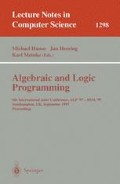Abstract
We show how to reduce the unification problem modulo βη-conversion and a first-order equational theory E, into a first-order unification problem in a union of two non-disjoint equational theories including E and a calculus of explicit substitutions. A rule-based unification procedure in this combined theory is described and may be viewed as an extension of the one initially designed by G. Dowek, T. Hardin and C. Kirchner for performing unification of simply typed λ-terms in a first-order setting via the λσ-calculus of explicit substitutions. Additional rules are used to deal with the interaction between E and λσ.
Preview
Unable to display preview. Download preview PDF.
References
M. Abadi, L. Cardelli, P.-L. Curien, and J.-J. Lévy. Explicit substitutions. Journal of Functional Programming, 1(4):375–416, 1991.
F. Baader and K. U. Schulz. Unification in the union of disjoint equational theories: Combining decision procedures. Journal of Symbolic Computation, 21(2):211–243, February 1996.
V. Breazu-Tannen. Combining algebra and higher-order types. In Proceedings, Third Annual Symposium on Logic in Computer Science, pages 82–90, Edinburgh, Scotland, 5–8 July 1988. IEEE Computer Society.
G. Dowek, T. Hardin, and C. Kirchner.Higher-order unification via explicit substitutions, extended abstract. In D. Kozen, editor, Proceedings of LICS'95, pages 366–374, San Diego, June 1995.
E. Domenjoud, F. Klay, and C. Ringeissen. Combination techniques for non-disjoint equational theories. In A. Bundy, editor, Proceedings 12th International Conference on Automated Deduction, Nancy (France), volume 814 of Lecture Notes in Artificial Intelligence, pages 267–281. Springer-Verlag, June/July 1994.
G. Huet. A unification algorithm for typed lambda calculus. Theoretical Computer Science, 1(1):27–57, 1975.
J.-P. Jouannaud and C. Kirchner. Solving equations in abstract algebas: a rule-based survey of unification. In J.-L. Lassez and G. Plotkin, editors, Computational Logic. Essays in honor of Alan Robinson, chapter 8, pages 257–321. The MIT press, Cambridge (MA, USA), 1991.
C. Kirchner and C. Ringeissen.Higher-Order Equational Unification via Explicit Substitutions. Research report, CRIN, 1997.
C. Mufioz. A left linear variant of λσ Manuscript.
G. Nadathur and D. Miller. An overview of λ PROLOG. In R. A. Kowalski and K. A. Bowen, editors, Proceedings of the Fifth International Conference and Symposium on Logic Programming, pages 810–827, Seatle, 1988. ALP, IEEE, The MIT Press.
T. Nipkow and Z. Qian. Modular higher-order E-unification. In R. V. Book, editor, Proceedings 4th Conference on Rewriting Techniques and Applications, Como (Italy), volume 488 of Lecture Notes in Computer Science, pages 200–214. Springer-Verlag, 1991.
B. Pagano. Extensions of lambda-calculi with explicit substitutions preserving the church-rosser's property. Manuscript.
Z. Qian and K. Wang. Modular higher-order equational preunification. Journal of Symbolic Computation, 22(4):401–424, October 1996.
A. Ríos.Contributions à l'étude des λ-calculs avec des substitutions explicites. Thèse de Doctorat d'Université, U. Paris VII, 1993.
W. Snyder. Higher-order E-unification. In M. E. Stickel, editor, Proceedings 10th International Conference on Automated Deduction, Kaiserslautern (Germany), volume 449 of Lecture Notes in Computer Science, pages 573–587, July 1990.
Author information
Authors and Affiliations
Editor information
Rights and permissions
Copyright information
© 1997 Springer-Verlag Berlin Heidelberg
About this paper
Cite this paper
Kirchner, C., Ringeissen, C. (1997). Higher-order equational unification via explicit substitutions. In: Hanus, M., Heering, J., Meinke, K. (eds) Algebraic and Logic Programming. ALP HOA 1997 1997. Lecture Notes in Computer Science, vol 1298. Springer, Berlin, Heidelberg. https://doi.org/10.1007/BFb0027003
Download citation
DOI: https://doi.org/10.1007/BFb0027003
Published:
Publisher Name: Springer, Berlin, Heidelberg
Print ISBN: 978-3-540-63459-1
Online ISBN: 978-3-540-69555-4
eBook Packages: Springer Book Archive

